 Palo Alto Stanford Heritage
Palo Alto Stanford Heritage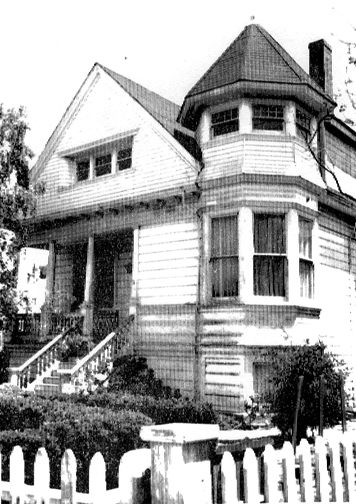 |
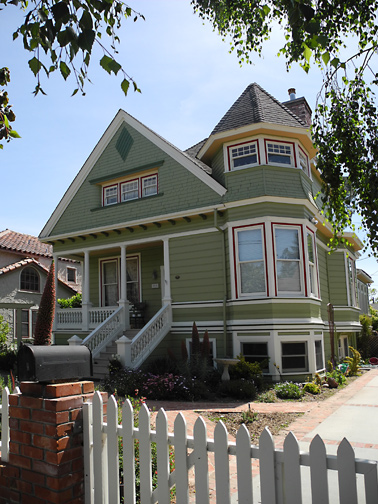 |
| Inventory photo | Photo taken April 23, 2014 |
The following is from the Historic Buildings Inventory as revised in 1985:
A small two-story house with a full complement of queen Anne devices—octagonal turret, fish-scale shingles, and shingled diamond in front gable. The house still has its original balustrade, but a part of the porch has been enclosed. A triplet of windows occurs in the turreted tower and the street-facing gable. The structure is surfaced in ship-lap.
This small, two-story house is an eye-catching fusion of nineteenth century forms and motifs, emphasizing Queen Anne styling. the octagonal tower is its most noticeable feature. A striking result of the miniature scale is the sharp juxtaposition of the turret and the gable of the main building mass. Among ornamental devices there are delicate horizontal grooving; fish-scale shingles; cut-work brackets supporting the side bay; shaped, dentil-like brackets beneath the pediment overhang; recessed ban of windows with diamond window above (now shingled) in the gable pediment; and turned spindles of the porch and stair balustrade.
This is an exceptionally elegant fusion of nineteenth century forms and motifs, emphasizing queen Anne styling on a miniaturized scale. It was one of several houses built for John S. and Isabel Butler, who owned the entire block at one time and whose large and elaborate Queen Anne styled house stood at the corner of Channing and Middlefield until after the mid-century. Butler came to California in 1852, and was a publisher in Idaho and Red Bluff. He served two terms as town trustee, helped found the library, and selected the location of the city's first wells.
The house was purchased in 1900 by Thomas Cardoza, an immigrant from the Azores whose dairy ranch was located across the fields near Bayshore Highway. The Cardozas occupied the house until 1925.
From 1928 to 1944 it was the home of L. S. Gerlough, who was the first doctor in Menlo Park but lived in Palo Alto. Emily, Mrs. Gerlough, was a handwriting expert, active in the early years of the city's theatre and Garden Club.
Later owners for periods of a decade were George P. Hurst (1946 to 1956), Joseph W. Kavanaugh (1959 to 1966), and Klaus and Felicitas Miede (1966 to 1984).
The owner in 1985 was Liza Loop.
The house was built in 1894 by William Pluns, one of several commissioned by John S. and Isabel Butler. The Butlers owned the entire block at the time, and their very large and elaborate Queen Anne styled house stood at the corner of Channing and Middlefield until after the mid-20th century. One of the very few Queen Anne type houses remaining from Palo Alto's earliest era, with associations to several families of consequence in the city's business, civic, and cultural affairs. It is a well-supported candidate for Category 2 standing in the Inventory.
The following is from the Centennial Buildings Tour, prepared by the City of Palo Alto Historic Resources Board for the Centennial Building Celebration, April 16, 1994. The 36 houses included on the tour were all identified as at least 100 Years old:
The forms and motifs emphasize Queen Anne styling on a miniature scale. This was one of several houses built for John and Isabel Butler, who at one time owned the entire block. Mr. Butler was a published and served two terms as town trustee, helped found the library, and selected the location city's first wells.
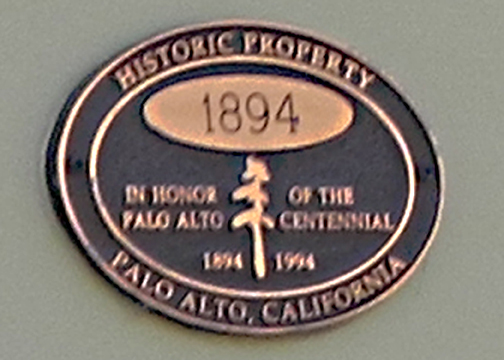 |
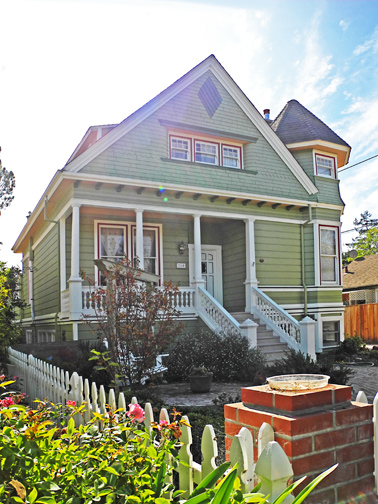 |
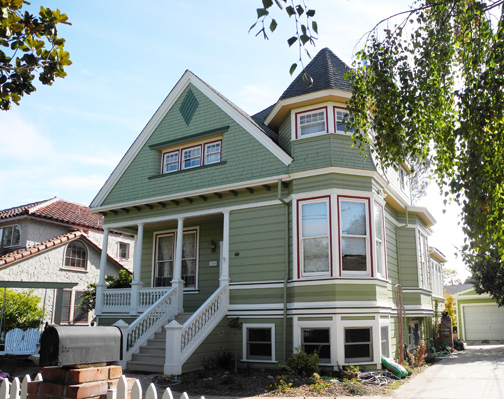 |
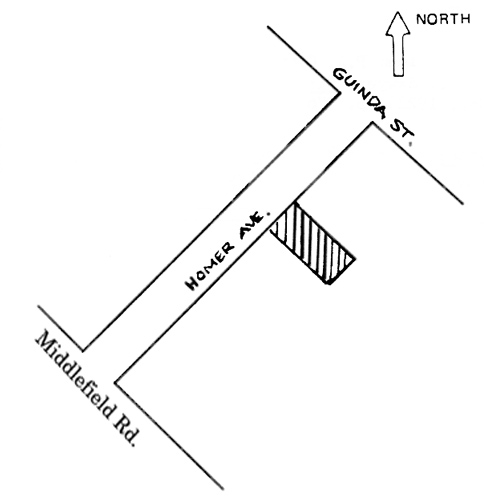 |
| Photo taken October 15, 2012 | Location map |
This house was built in 1894 and is a Category 2 on the Historic Buildings Inventory. The builder was William Pluns. The property measures 50 by 110 feet.
Sources: Palo Alto City Directories; Palo Alto Times 1/5/94, 10/30/16, 7/22/25, 9/24/68; Eugene T, Sawyer, History of Santa Clara County... (Los Angeles, Historic Records Co., 1922), p. 976; Palo Alto AAUW, ... Gone Tomorrow?, p. 17.
E-mail us at either webmaster@pastheritage.org or president@pastheritage.org.
![]() Palo Alto Stanford Heritage—Dedicated to the preservation of Palo Alto's historic buildings.
Palo Alto Stanford Heritage—Dedicated to the preservation of Palo Alto's historic buildings.
Copyright © 2016 Palo Alto Stanford Heritage. All rights reserved.